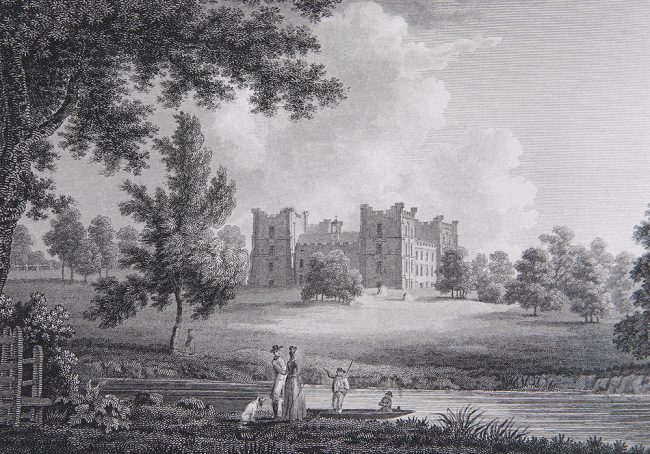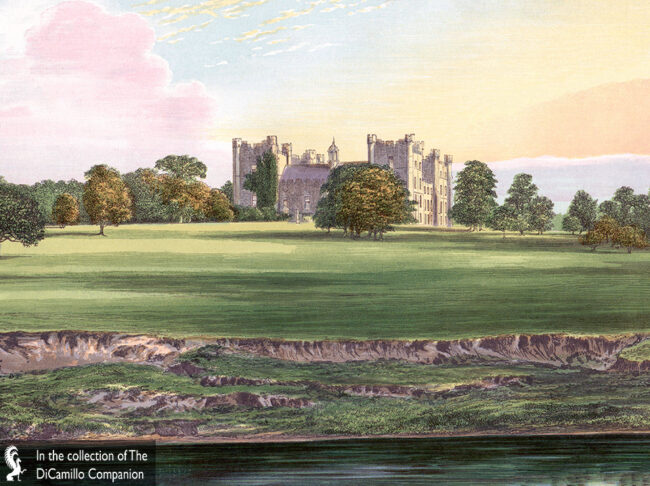
A 1794 engraving of the house from "Angus's Views of Seats." By kind permission of a private collection.

An 1831 engraving of the house from "Neale's Views of Seats"

The house from an 1885 lithograph that appeared in "Morris's County Seats"

Earlier Houses: Parts of an earlier dwelling are incorporated into the current castle.
House & Family History: Lumley Castle was built by Sir Ralph de Lumley, who obtained permission from King Richard II to convert the existing manor house built by his father or grandfather in the mid-14th century into a castle. Though the castle was not lived in at the time, in 1807 virtually all the contents were sold because of the family's compromised financial position. At the beginning of the 20th century Frederica, Countess of Scarborough, lived in Lumley and made it her mission to reassemble as many of the former castle furnishings as possible. In 1972 the Lumley family let the castle to a hotel group; it remains a luxury hotel today.
Collections: Housed in Lumley Castle and Nonsuch Palace, the Lumley Collection was the largest art collection in Elizabethan England (it included almost 300 paintings, including portraits of 196 contemporary sitters). Created by John Lumley, 1st Baron Lumley (of the third creation), through purchase and commission, the core of the collection was inherited by Lord Lumley from his father-in-law, the 12th Earl of Arundel (from whom he also inherited Nonsuch Palace) and included pictures from the collection of Elizabeth I’s favorite, Robert Dudley, 1st Earl of Leicester. Lord Lumley was unusually cultured for his time. Before such a thing as the Grand Tour existed, he traveled in Italy and spent significant time in Florence in the 1560s. Lord Lumley was also the uncle of Thomas Howard, 14th Earl of Arundel (“the Collector Earl”), possibly 17th century England’s most important collector. Lord Arundel inherited some of Lumley’s collection of paintings, including the famous portrait by Hans Holbein the Younger of Christina of Denmark, Duchess of Milan (today in the National Gallery, London; see “Images” section). However, a significant portion of the collection remained at Lumley Castle, where it was eventually inherited by the earls of Scarbrough and sold in sales in 1785 and 1807. All of this was documented in “The Lumley Inventory,” also called “The Lumley Inventory and Pedigree” and “The Red Velvet Book” (from its binding), called by Sir Roy Strong “…the most important single document for the history of painting, sculpture, and furniture in the Elizabethan age.” Compiled for Lord Lumley circa 1586-95 by his steward, John Lampton, the illustrated manuscript documents Lumley’s enormous collection of paintings, sculpture, silver, furniture, and books, and also includes a heraldic and genealogical history of the Lumley family that traces their ancestry back through Charlemagne to Adam. The inventory also includes illustrations of garden fountains and outdoor sculpture at Nonsuch Palace, including the Pelican Fountain, today at Sandbeck Park. Now owned by the earls of Scarbrough, the inventory is on long term loan to the Victoria & Albert Museum. In 2010 the Roxburghe Club privately printed a reproduction of “The Red Velvet Book,” 250 copies of which were made available for sale from the London rare book and manuscript dealer Maggs Bros.
Architect: John Vanbrugh
Date: 1722John Bernard (J.B.) Burke, published under the title of A Visitation of the Seats and Arms of the Noblemen and Gentlemen of Great Britain and Ireland, among other titles: 2.S. Vol. I, p. 163, 1854.
John Preston (J.P.) Neale, published under the title of Views of the Seats of Noblemen and Gentlemen in England, Wales, Scotland, and Ireland, among other titles: Vol. I, 1818.
Country Life: XXVII, 896 plan, 1910.
Title: Treasure Houses of Britain, The - SOFTBACK
Author: Jackson-Stops, Gervase (Editor)
Year Published: 1985
Reference: pg. 412
Publisher: Washington, DC: National Gallery of Art (New Haven: Yale University Press)
ISBN: 0300035530
Book Type: Softback
Title: Biographical Dictionary of British Architects, 1600-1840, A - SOFTBACK
Author: Colvin, Howard
Year Published: 1995
Reference: pg. 1008
Publisher: New Haven: Yale University Press
ISBN: 0300072074
Book Type: Softback
House Listed: Grade I
Park Listed: Grade II
Past Seat / Home of: Sir Ralph de Lumley (Lumley), 1st Baron Lumley (first creation), 1390-1400; John Lumley, 1400-21; Thomas Lumley, 1st Baron Lumley (second creation), 1421-85; George Lumley, 2nd Baron Lumley, 1485-1507; Richard Lumley, 3rd Baron Lumley, 1507-10; John Lumley, 4th Baron Lumley, 1510-45; John Lumley, 1st Baron Lumley (third creation), until 1609; Richard Lumley, 1st Viscount Lumley, 1609-63; Richard Lumley, 2nd Viscount Lumley and 1st Earl of Scarbrough, 1663-1721; Richard Lumley, 2nd Earl of Scarbrough, 1721-39; Thomas Lumley-Saunderson, 3rd Earl of Scarbrough, 1739-52; Richard Lumley-Saunderson, 4th Earl of Scarbrough, 1752-82; George Augustus Lumley-Saunderson, 5th Earl of Scarbrough, 1782-1807; Richard Lumley-Saunderson, 6th Earl of Scarbrough, 1807-32; John Lumley-Savile, 7th Earl of Scarbrough, 1832-35; John Lumley-Savile, 8th Earl of Scarbrough, 1835-56; Richard George Lumley, 9th Earl of Scarbrough, 1856-84; Frederica, Countess of Scarborough, 1884-1907; Aldred Frederick George Beresford Lumley, 10th Earl of Scarbrough, 1907-45; Lawrence Roger Lumley, 11th Earl of Scarbrough, 1945-69.
Current Ownership Type: Individual / Family Trust
Primary Current Ownership Use: Hotel
Ownership Details: Owned by the Lumley family and let to Lumley Castle Ltd., who operate it as a hotel.
House Open to Public: By Appointment
Phone: 01913-891-111
Fax: 01913-895-871
Email: [email protected]
Website: https://www.lumleycastle.com/
Historic Houses Member: No